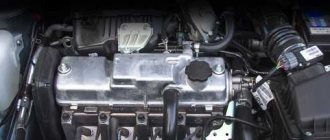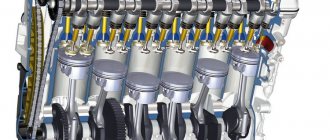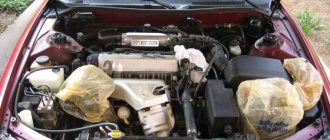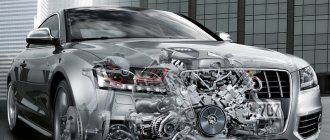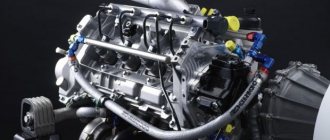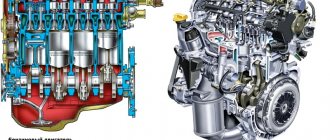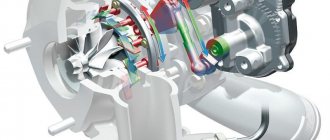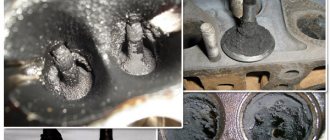Warming up the engine
The move away from carburetor internal combustion engines has led to the fact that warming up the engine is no longer considered necessary.
The injection system ensures a uniform supply of fuel to the cylinders with control of this process by the ECU. As a result, normal engine operation does not depend on its temperature. It follows that the movement of the machine is possible without preheating the unit. This is explained from a technology point of view, the need to preserve the environment and fuel economy, but not by the resource of the internal combustion engine. Meanwhile, any engine is metal, and it is known to be subject to expansion. Some engine parts heat up faster, while others heat up more slowly.
This suggests a conclusion: it is advisable to load the internal combustion engine only after preheating, regardless of the time of year, although in winter this is more important
Engine resource. Extension secrets
Engine life as a concept is today overgrown with many myths and guesses. This is because car owners have different attitudes to the rules of car operation, which is why the same power unit can run normally for 500 thousand kilometers, or it can stall forever in the second hundred.
Why can this happen and how can you maximize the life of an average passenger car engine? Let's look at this issue point by point, because there are many factors that are worth paying attention to:
- running-in – when buying a car from the showroom, you should not immediately test it for maximum speed and load capacity. The fact is that even though automakers assure us that running-in is not necessary for a modern engine, it is still necessary to operate the power unit in a gentle mode for the first 2-3 thousand kilometers - revs no higher than 3 thousand, no racing, hauling trailers, etc. driving over hard bumps;
- lubricants - to the delight of car owners, the chemical industry these days produces very good oils that can significantly increase the durability of the engine. They not only lubricate efficiently, but also clean the rubbing parts of engines. Synthetic oils are especially good because they do their job perfectly even in cold weather, which was a big problem in previous years. The only disadvantage of good “synthetics” is the price, which is why many drivers save on lubricants, which predicts a decrease in engine life;
- cooling system - internal combustion engines generate a huge amount of heat during operation, which must be effectively removed. The better and more efficiently the system functions, the greater the chance that the engine will travel hundreds of thousands of kilometers without problems. The owner of the car can influence it by filling it with high-quality coolant - there is no need to skimp on this either.
Knocking in the engine - its causes and consequences
What is the efficiency of a diesel engine? diesel and gasoline engine
Many car enthusiasts are familiar with the situation when, over time, a knock appears in the engine of your car. And once this happens, most drivers want answers to two questions:
- where did this knock come from;
- how long it will be possible to drive before repairs and the complexity of the necessary repairs.
First of all, you should understand the question of where the knocking came from and what is its cause. However, it is quite difficult to answer this question without disassembling the engine. Also, it is very difficult to answer the question of why the knocking occurred if you do not disassemble the engine.
Most often, knocking occurs due to the fact that a gap appears between the parts between them, which increases. If there is enough lubrication and coolant, then knocking can only occur if this gap is twice the nominal one. With a gap of three or more times, this knocking becomes very audible. It is also obvious that knocking in the engine means that one part hits another, resulting in the destruction of engine parts. The rate at which parts wear out when knocking occurs depends on many factors, including:
- engine's type;
- type of materials;
- amount of lubricant;
- effective loads, etc.
True, there are cases when knocking occurs even without wear of parts and normal clearance. The reason why such a knock occurs is misalignment, very heavy loads and low oil viscosity. And if the parts are not damaged, after eliminating the causes, the knocking disappears. The appearance of a knocking sound in the engine of your KIA is an urgent reason for diagnostics of your KIA. How much work your KIA needs to do depends on how correctly the cause of the knocking is determined. Of course, to do this, the engine of your KIA will need to be removed. Although there are times when you only need to partially disassemble the KIA engine.
Engine knocking when cold
Sometimes it happens that after starting a cold KIA engine, a knock appears, and after it warms up, it disappears. There is nothing wrong with KIA in this case, and this is due to the fact that the engine of your KIA is not new at all and you need to warm it up before the trip.
Engine knocking when hot
If the engine of your KIA knocks on the road, the situation with your Rio will be much more complicated, since it will be quite difficult to do anything in this situation. Of course, you can check the engine oil level of your Rio. Often, as practice shows, knocking occurs precisely because of the small amount of lubricant in the Rio. After adding oil to the Rio engine, the knocking stopped. After this, you need to determine for yourself whether the knocking in your Rio becomes stronger under load.
In addition, how loud the knocking noise becomes in your Rio when driving is also very important. If the knocking intensifies, then most likely this is damage to the crankshaft bearings and this is very dangerous. If you hear one of the fading knocks, then you may need to adjust the engine. Such a service as adjustment will be performed by car service specialists. Very often, adjusting the valves helps solve the knocking problem, but adjusting the valves yourself is quite risky and difficult. Therefore, it is necessary that valve adjustment be carried out only by very high-class specialists.
How to extend the life of a car engine?
The sound of an unheated/warm-up engine Kia Rio 2013
Kia Rio III engine operation
The operation of the new KIA RIO engine (GAMMA 1.6) - NOTHING WORRY))
Kia Rio III engine operation
The knock of the gamma 1.6 engine on the new KiA RiO can be heard in the cabin
KIA RiO Starting the engine at -40
Of course, if there are no malfunctions in the engine and it is working normally, then there is no need to go anywhere to avoid problems. However, engine malfunctions require specialist intervention. This will prevent serious damage.
Service life of modern engines
Depending on the model and operating mode, the average service life of a modern foreign-made power unit is 300,000 – 350,000 km.
Russian cars are equipped with engines designed for 150,000 - 200,000 km. Of course, proper care and maintenance can increase the resource of the internal combustion engine to the desired 300,000 - 400,000 km, while an irresponsible attitude towards the car will lead to a major overhaul of the engine after the first “hundred”. How to extend the life of a car engine?
- Follow the correct engine starting mode in cold weather. To achieve the optimal degree of viscosity of the lubricant inside the unit, it is necessary to warm up the system for approximately 5-10 minutes, depending on the air temperature and engine type.
- Protect the engine from overheating. In addition to timely oil changes, it is necessary to take care of the proper condition of the cooling system. The refrigerant, or coolant, enters the engine compartment through a pump and reduces the temperature at the right time. Make sure that the colored liquid fills the corresponding tank to the special mark.
- Change the air filter whenever it gets dirty. Regardless of the manufacturer's recommendations, check the condition of the filter often. If it is clogged with debris, the engine cannot operate at full capacity.
- Do not empty the fuel tank. Even in high-quality fuel, sedimentation of substances harmful to the engine is possible. Driving a car with a nearly empty tank can cause debris to enter the engine and damage the fuel pump.
- Check the drive belts for integrity. The rubber elements of the belt drive are subject to rapid wear and cracking. Inspect these parts carefully to avoid unexpected damage to the generator, fan and other systems.
If you find a malfunction in the system of components and mechanisms of the power unit or hear suspicious engine sounds, contact specialists at the official service centers of FAVORIT MOTORS Group of Companies.
We will conduct thorough computer diagnostics, eliminate defects, and, if necessary, carry out high-quality engine overhauls at affordable prices. Take care of the safety and good technical condition of your car. Contact the professionals! Spare parts Technical center Ask a question
TSI motor problems
What is the service life of an engine on a VAZ-2114 with 8 valves?
Increased oil consumption in a TSI engine, especially the new generation of lightweight engines. Consumption per 1000 km is considered acceptable. up to 1 liter. In our opinion, this is crazy, and then what’s the point of saving fuel if you go broke on oil. Power units with an aluminum block are quite durable. But at the same time, they are very sensitive to the quality of fuels and lubricants and timely maintenance. The main problem with TSI with an aluminum block is low quality gasoline. Products of incomplete combustion, which are contained in low-grade fuel, form soot, coke and other deposits on piston rings, valves, and cylinder walls. The result of the formation of coke and carbon deposits is loss of mobility of the rings, loose valve fits, decreased pneumatic tightness of the cylinders, and as a consequence, loss of power and increased oil consumption. In addition, products of incomplete combustion enter the oil, which causes its aging and loss of performance characteristics.
And, if we take into account the small volume of the oil system in the 1.2 and 1.4 power units, then their oil aging occurs much faster than in engines with large volumes of oil. EA111 models took a long time to warm up in the cold season
This problem leads to severe carbon formation, since when driving short distances the engine does not have time to warm up, which means fuel consumption increases, and along with it carbon deposits, which leads to a decrease in service life. Increased noise, “clanging” and “rattling” caused by the timing chain drive on TSI engines due to its stretching. In theory, a chain drive should last much longer than a belt, but in practice, with engines 1.2 and 1.4, everything happens differently, and the service life is on average 50 thousand km. mileage As mentioned above, problems begin with fuel and go to oil. Carbon and abrasive products found in the oil negatively affect the operation of the chain tensioner. As a result, over time the chain stretches, which leads to characteristic noise.
Five systems that reduce car engine life
It is no secret that new engines are developed based on the requirements of efficiency and environmental friendliness, while consumer characteristics are relegated to the background. As a result, the reliability and service life of the engine decreases.
When choosing a car, you should take this trend into account. There is a list of characteristics that inevitably reduce engine life.
The first point is reducing the volume of combustion chambers. This reduces the emission of harmful substances into the atmosphere. At the same time, the indicated engine power is provided due to an increased compression ratio, which improves the combustion rate.
The compression ratio is limited by the fuel characteristics and the materials from which the piston mechanisms are made. If the compression ratio increases by a third, the impact on the piston and moving parts doubles. From this point of view, 1.6-liter 4-cylinder engines have optimal consumer properties in passenger cars, writes aif.ru.
The second point is the use of pistons with a short skirt. The manufacturer's logic is as follows. The smaller the piston, the lighter it is. And thanks to this, it provides greater impact and efficiency. A reduction in the piston skirt combined with a reduction in the connecting rod arm entails an increase in the load on the cylinder walls. At high speeds, such a piston sometimes breaks through the oil film and comes into contact with the metal of the cylinders. Which, of course, does not prolong the service of the piston group.
Third on the list is the use of turbocharging on small-volume engines. The most common type is turbocharging, which uses exhaust gas energy to rotate a centripetal turbine. The temperature in it reaches 1000 degrees. The greater the liter engine power, the greater the wear. Most often, the turbo unit breaks down at the threshold of 100 thousand kilometers. The turbine can quickly damage the piston part, since the turbocharger will take the entire supply of engine oil.
The fourth point is the lack of engine warming up at subzero temperatures. Indeed, modern engines can start working without warming up thanks to the latest injection systems. As the temperature drops, the load on the parts increases sharply: the engine needs to pump the oil and warm up for at least five minutes. But due to environmental requirements, manufacturers omit this recommendation. And the service life of the connecting rod and piston group is reduced.
Fifth on the list is the start/stop system. It was invented by German automakers to cut off the idling mode, during which a lot of harmful substances are released into the atmosphere. As soon as the vehicle's speed drops to zero, the system turns off the engine. The problem is that each motor is designed for a certain number of starts. Without this system, in 20 years the engine will start, on average, 100 thousand times. With her - about 10 million. The more starts, the more wear on the rubbing parts occurs.
Service life of different types of engines
Engine life of Toyota Land Cruiser Prado 2.7, 2.8, 3.0, 3.4, 4.0
Many motorists are interested in the answer to the question of which engine lasts longer. Indeed, there are several types of engines, and it is logical to assume that two-stroke, four-stroke and rotary engines have different safety margins. Car owners are no less interested in whether the service life of a diesel engine differs from that of a gasoline engine.
The two-stroke gasoline engine of a motorcycle has the smallest safety margin. This is explained mainly by high crankshaft speeds. The second reason lies in absence as such. The cylinder-piston group of a two-stroke engine is lubricated with a working mixture; for this, oil is added to gasoline.
At different operating modes, a motorcycle engine requires different amounts of lubricant, and it is not possible to change its supply. As a result, the motor receives normal lubrication only in certain operating modes, and under heavy loads it may experience oil starvation.
The rotary or, more correctly, things are little better. By the way, the only automaker that serially installs such engines in its cars is Mazda. Engines of this type are installed on its RX series models (for example, MazdaRX-8).
The service life of a rotary engine is short compared to four-stroke engines operating on the Otto cycle. With proper and timely maintenance, it does not exceed one hundred thousand kilometers.
On average, given that the MazdaRX-8 is not purchased for quiet trips, the car’s engine requires overhaul or replacement after fifty to sixty thousand.
A gasoline four-stroke engine has a significantly higher service life than the two above-mentioned. For foreign cars it is more, for domestic, and even more so, Chinese cars it is less, but nevertheless, it amounts to hundreds of thousands of kilometers. There are cases when a car engine went 500 thousand km without major repairs. Moreover, the layout of the cylinders does not matter at all.
Subaru owners like to boast that boxer engines last longer, but this is not at all true. Fundamentally, a Subaru car is no different from any g4fc, so it makes no sense to talk about which power unit will last longer without major repairs. In favor of the same in-line g4fc, we can say that it is much simpler and cheaper to maintain.
Speaking about the resource of turbo engines, it is more correct to talk about the safety margin of the turbine itself, which fails many times faster, and without it the engine turns into an ordinary aspirated engine.
The lifespan of a turbine is usually about one hundred thousand kilometers, after which either turbine repair or (more often) replacement is required. The service life of the turbine is significantly affected by the driver's compliance with the rules for operating a car with a turbo engine.
Diesel has the longest engine life. There are two reasons for this. Firstly, diesel power units are made from stronger alloys due to the high compression ratio. The second reason lies in their slowness. If a gasoline engine has operating speeds, as a rule, of 3-4 thousand, then a diesel engine has half that, i.e. 1.5–2.
Accordingly, for the same mileage under the same conditions, the pistons of a diesel engine will make half as many translational movements, i.e., physical wear will also be significantly less. Here is a table that summarizes the resources of different types of engines.
Resource depending on engine type
In many ways, the service life of engines can be judged by what type of power plants a particular unit belongs to.
Despite the fact that the resource for modern engines is about 300 thousand kilometers, this is an average value. For a more accurate determination, it is important to consider what type of motor we are talking about in a particular case.
Companies do not openly admit this, but in reality, for new passenger cars, the service life of installed engines is artificially reduced. How exactly this is done is up to each manufacturer to decide for himself. But for modern cars, this phenomenon has become the norm.
Therefore, it is quite natural that car enthusiasts are actively interested in which engine designed for a passenger car has the longest resource.
The question is more than fair, since rotary, two-stroke, four-stroke and other power units really have different safety margins. Using the example of different types of engines, it is worth finding out what the service life is in a particular engine, and how the service life of a gasoline engine differs from a diesel engine.
- The smallest safety margin is observed in two-stroke engines running on gasoline, which are installed on motorcycles. This is due to very high crankshaft speed parameters. There is also virtually no lubrication system, which also negatively affects the lifespan. To lubricate the cylinder-piston group, a mixture of fuel and oil is used. By changing the operating mode, such engines require different amounts of lubrication, but the motor system cannot change this parameter. That is, the engine is normally lubricated when only in certain operating modes. When the load is increased, the effect of oil starvation is observed. Hence the small resource.
- Rotary power plants perform noticeably better. Currently, such engines are rare. There is only one automaker that uses rotary internal combustion engines in series. This is the Japanese company Mazda. Moreover, they are available on a limited number of models. The engine life in this case exceeds two-stroke engines, but is inferior to classic four-stroke solutions. Even if the rotor system is properly and promptly maintained, its service life will not exceed 100-150 thousand kilometers. But since such engines are installed on production sports cars, the actual mileage before major repairs is usually no more than 75 thousand kilometers.
- Four-stroke petrol. These engines are superior in terms of service life to both previously discussed engines. Moreover, the engine life of foreign cars is longer than that of domestic designs. But even in this situation, the lifespan is hundreds of thousands of kilometers. It’s not that uncommon for four-stroke bikes to travel over 500 thousand kilometers. Similar parameters are relevant for all types of four-stroke gasoline engines, regardless of the cylinder layout used.
- Boxer power plants. A characteristic feature of Japanese cars produced by Subaru. Owners of these cars often claim that boxer units are very durable and are supposedly superior to competitors of the four-stroke gasoline type. But there are no significant and fundamental differences in terms of service life between these units. Therefore, it is unfair to say that boxers have a long service life. Plus, classic four-stroke engines are simpler in design, which simplifies their maintenance and reduces the cost of repair work.
- Turbocharged engines. If we talk about their durability in relation to turbo engines, then the main attention is paid to the service life of the turbine itself. It cannot boast of long-term trouble-free operation, although the engine itself can continue to perform its functions efficiently for a long time. But as soon as you remove the turbine from the turbo engine, it turns into a standard and most common naturally aspirated engine. The average turbine service life is 100 thousand kilometers. After this, it needs to be repaired, but more often the element is completely replaced. The more correctly the driver adheres to the recommendations for operating a turbo engine, which differ from atmospheric analogues, the longer the turbocharged power plant will last.
- Diesel engines. These are motors with the longest service life and safety margin. There are explanations and reasons for this. To begin with, high-strength alloys are used in the production of diesel engines, which is due to the increased compression ratio. Plus diesels are slower. We're talking about revolutions. If standard gasoline engines usually move at a speed of 3-4 thousand units in operating mode, for a diesel engine the current figure is 1.5-2 thousand revolutions. In other words, with equal mileage, the pistons on a diesel power plant perform 2 times less reciprocating movements than on gasoline counterparts. And this directly affects physical wear and tear.
You can clearly see that engines of different types can indeed differ significantly in terms of service life. The service life largely depends on the design features of the motor.
And if we talk about cars, rotary engines are the weakest in terms of service life. But the best performance is demonstrated by four-stroke gasoline engines and diesel units.
Taking into account the average indicators, the following companies can be considered manufacturers of the most durable engines:
- Nissan;
- Volkswagen;
- Ford;
- Toyota;
- Mercedes.
It is almost impossible to say exactly how long a particular vehicle can travel before major repairs. Everything is very individual and depends on a number of factors.
Under favorable conditions and with adequate operation, there is every chance to overcome the mark of 500-600 thousand kilometers using reliable engines. If you overload the engine, regularly drive on bad roads, fill with bad fuel and do not change consumables in a timely manner, then even the most theoretically durable engines will not last even 150 thousand kilometers with a potential of more than 500 thousand km.
Pros, cons and resource
I'll start with the resource - this will be the first advantage. The manufacturer gives about 200,000 km, but now there are cars since 2010 that have already covered 500 - 600,000 km and you know, the engines work, no matter what (no matter how much they are scolded).
Indeed, the units are problem-free, and they often do not run on the best 92 gasoline. It is worth noting the convenient location, everything can be reached and easily replaced (spark plugs, air filter), intake and exhaust manifolds, engine mounts
Short inlet, and this is not unimportant (the shorter it is, the less pumping losses due to suction). Also, there is not such a large volume of plastic as is now in many modern engines.
The main thing is to maintain it on time (I still recommend you change the oil every 10,000 km), use high-quality synthetics (there is still a phase shifter and a chain tensioner), and fill in 95 gasoline.
On the downsides (although these are not downsides, but my recommendations). The noisy operation of the fuel injectors is not fatal, but it is a fact (it does not seem to be a chattering chain). There are no hydraulic compensators (there are ordinary pushers) they need to be changed (by selecting new ones according to height) approximately once every 100,000 km. It is also advisable to replace the chain mechanism, and the timing chain itself, up to 150,000 km. Sometimes there are problems with the catalyst (it can simply crumble), crumbs from it get into the cylinders and can very quickly kill the engine. The problem is not widespread, but it happens, as dealers assure, from low-quality fuel, so refuel at normal gas stations
HBO and resource
Gas equipment has become extremely in demand against the backdrop of the constant rise in gasoline prices. To convert a car to gas, a set of equipment is purchased, and certain modifications are made to the engine fuel system. How does HBO affect engine life, and does it have an effect?
A properly configured gas system has virtually no effect on the engine, despite the widespread myth about inevitable burnout due to elevated combustion temperatures. The engine life on gas and gasoline, subject to installation and operation standards, is the same.
Important: a qualified specialist must install the LPG, configure it and the engine. Incorrect manipulations can lead to rapid failure, as well as non-compliance with operating rules.
The main problems of engines with LPG arise from poor tuning:
- Leaning of the gas-air mixture
It leads to an increase in combustion temperature and a prolongation of the engine combustion cycle. As a result, the seats and valves themselves burn out, spark plugs quickly break, and the engine constantly experiences overheating. If you do not pay attention to the problem, it will progress, the combustion process in the cylinders will be disrupted, and the service life of the gas engine will drop catastrophically.
- Over-rich mixture
How to increase the resource of an internal combustion engine
https://youtube.com/watch?v=ua066Q-oYFM
As you may have guessed, the service life of the engine depends not only on the material of its manufacture and technical projection characteristics, but also on the driver himself, or more precisely, on the correct maintenance of the power plant.
First of all, the driver must use for lubrication only high-quality oil that has passed special testing and is approved for use on a given type of engine. After all, the lubrication system is the “blood” of any engine and its life depends on its contents.
Oil for a diesel engine must be selected taking into account the applied loads. If you intend to use the engine in conditions close to extreme, it is recommended to fill only with oil with a high viscosity coefficient to avoid its dilution when the temperature rises. The type and brand of oil can also be found out by reading the technical data sheet for the power unit. It indicates all the characteristics of oils used on the engine under various conditions.
Experienced drivers know that a diesel engine is very sensitive to sudden increases in temperature. This phenomenon has a more serious impact than the quality of the oil being poured. To avoid overheating and increase engine power, you can install a turbo compressor connected to an intercooler, which will help maintain the engine at the temperature it needs.
That's probably all you need to know about the service life of a diesel engine. As you can see, the price to pay for a powerful and reliable motor is considerable, because you will have to stock up in advance on expensive spare parts and automotive chemicals that can save you from unnecessary expenses and preserve the life of the motor, even if quite large dust particles have flown into it.
How to extend engine life
There are several simple tips on how to extend engine life:
- Fill the tank with the recommended fuel. If the manufacturer specifies 95 gasoline, you should not try to save on fuel with a lower octane number. The engine will operate in an abnormal mode and will fail faster;
- to extend engine life, you need to use the right oil and follow the rules for changing it;
- Fill in high-quality antifreeze and change it on time. Important: it is better not to pour water into the radiator, since its corrosive activity will render the entire system unusable;
- monitor the air filter and change it promptly;
- operate the car without sudden starts and accelerations using the “slippers to the floor” method, make sure that the engine does not operate at too high speeds;
- undergo engine maintenance in a timely manner and eliminate any faults found. It is important to pay attention to any problems so that they do not develop into major repair problems.
4th place: Mitsubishi
The Mitsubishi 4B11 series engine opens a subgroup of engines free of serious illnesses. It was installed on the previous generation Outlander and Lancer X in the first years of production.
Engine life is 180,000-200,000 km. The workmanship of its elements is good. The overall reliability of the motor is largely due to the simplicity of the design, devoid of capricious systems. As a rule, engines reach repairmen due to natural wear and tear of the cylinder-piston group.
The motor is a repair size. Original spare parts are available separately.
In terms of restoration cost, a Mitsubishi engine is comparable to Renault, Nissan, Ford, and Mazda engines.
Motor resources of leading car manufacturers
Engine life is one of the most significant parameters among its technical characteristics. However, it is quite conditional, since it depends on many different reasons.
The same engine, operated under different conditions, can exhaust its service life both within 100 and 300 thousand kilometers.
Manufacturers of automobile engines in the accompanying documentation, as a rule, indicate the amount of mileage during which, if used correctly, nothing will happen to it. In this case, the actual engine life can be much longer.
For example, for domestically produced power units, the engine warranty life is 150 thousand kilometers, but there are a large number of cars in operation with a mileage of more than 250 thousand kilometers, the owners of which have not had any problems with the engines.
As for foreign engines, quite recently their manufacturers tried to ensure that the engine life corresponded to the service life of cars (the so-called “million-dollar engines”).
However, then leading engine companies changed their approach to the production of power units, not without reason believing that instead of increasing the reliability of engines, it was more profitable to sell spare parts for them. Therefore, the warranty service life of modern engines has been artificially reduced and currently does not exceed 300,000 kilometers.
Using publicly available data provided in various sources, you can summarize the data on the motor life of power units from various manufacturers into a table:
| Motor manufacturer company | Engine service life (thousand km) |
| VAZ | 100 — 200 |
| Hyundai | 150 — 250 |
| Kia | 150 — 250 |
| Chevrolet | 150 — 300 |
| Opel | 150 — 300 |
| Subaru | 150 — 400 |
| Renault | 250 — 400 |
| Suzuki | 250 — 400 |
| Daewoo | 250 — 400 |
| Skoda | 250 — 450 |
| Peugeot | 250 — 450 |
| Mazda | 250 — 500 |
| Mitsubishi | 250 — 500 |
| Nissan | 250 — 500 |
| VW | 250 — 500 |
| Ford | 300 — 500 |
| Saab | 400 — 500 |
| Toyota | 300 — 600 |
| Mercedes | 300 — 600 |
| BMW | 300 — 600 |
New heart, new life
The model entered the automobile market with two types of single-row four-cylinder Gamma engine, the volumes of which are 1.4 and 1.6 liters, respectively. The first heart of the Kia Rio beats with a power of 107 hp. With. and torque -135 N/m. Another, 1.6 liters, lives at a purity of 123 liters. With. and 155 N/m of torque. Another surprising thing is that, compared to previous Kia Rio engines, these Gamma engines have significantly reduced fuel consumption and emissions of harmful gases into the atmosphere. At the same time, improving the average technical indicators. This means that there has been a worthy replacement for the old Alpha engine with a volume of 1.4 liters. The transmission on the new Kio Rio is represented by four types of control, two automatic and two manual:
- 6s automatic and manual;
- 5-speed manual;
- And a 4-speed automatic;
All this significantly affected the dynamic performance of the Kia Rio. Thus, a 1.4-liter engine reaches a hundred in 13.6 seconds, developing a maximum of 168 km/h at such indicators. And its brother Gamma 1.6 will be a little faster at a hundred, in 11.3 seconds. The highest speed of this trotter is 178 km/h.
Diesel resource compared to gasoline internal combustion engines
There is an opinion that the service life of a diesel engine is up to two or more times longer than that of gasoline engines. Since the compression ratio of diesel engines is higher, materials of increased strength are used to manufacture diesel engines.
The cylinder block of a diesel internal combustion engine is made of cast iron, while aluminum alloys are widely used for gasoline engines. Parts of the cylinder-piston group and crankshafts of diesel engines are manufactured in accordance with higher standards and tolerances to increase their strength. The result is that, under optimal operating conditions, a diesel unit can operate longer than a gasoline unit without major repairs.
Another feature of a diesel engine, which provides a longer service life, is reaching maximum torque at low crankshaft speeds. A gasoline engine begins to “pull” well in the range of 3.5-4.5 thousand rpm; for a diesel engine, confident traction begins at 1.5 thousand rpm. The number of piston strokes is reduced, which means noticeably less wear.
As practice shows, although diesel engines in passenger cars from world brands are superior to their gasoline counterparts in terms of durability, it is wrong to consider them much more reliable only on the basis of their service life. Experts note that referring to a large resource is completely fair only in relation to heavy diesel trucks.
Diesel cars with a volume of 1.9 to 2.2 liters have an average declared resource of about 300-350 thousand kilometers, which is almost the same as gasoline models.
Small cars running on diesel fuel naturally have an even shorter lifespan. Also, the weak point of diesel engines is the fuel equipment, the maintenance and repair of which in some cases is more expensive than a qualified overhaul of a gasoline internal combustion engine.
Average life of modern engines
There is a widespread belief that many old foreign cars have practically “indestructible” engines, whose guaranteed operating range is up to a million kilometers. And this figure is quite realistic if you carry out regular preventive maintenance and maintenance of the engine.
“Millionth” Toyota 1JZ-GE engine:
Over time, however, the reins of power in the automotive industry have passed from engineers to marketers, whose task is to ensure constant market rotation and stable demand for automotive products. Therefore, engines are no longer made to be extremely reliable.
In addition to the purely financial reasons for this decision, there is another one: the average driver simply will not have time to “drive” even half a million kilometers in an acceptable time. With the “home-work-dacha” travel mode and an average mileage of 30 thousand per year, it will take about 15 years for the engine to reach the 500 thousand mark, during which time the car will become hopelessly outdated and will no longer meet current standards and norms. Therefore, today, with rare exceptions, people do not worry about high reliability.
How the company's revenue, profit and assets changed
The following graph shows how the revenue and net profit of DVS Resource LLC changed.
Graph of changes in revenue and net profit by year
Net assets (equity) and the total assets of the organization changed as follows:
Chart of changes in assets and net assets by year
* The organization’s capital is indicated as an indicator of net assets. Additional accounting data is required to accurately calculate net assets.
Net assets show the amount that is subject to distribution among the owners of the company in the event of the sale of property and the repayment of all obligations of the organization. See also 2021.
Resource of modern engines
As a rule, the question of how long the engine of a particular car has is asked by drivers who plan to purchase a car on the secondary market. In other words, this topic is of more concern to used car buyers. It is quite logical that after purchasing a used car, not everyone will want to spend money on major engine repairs after 30-50 thousand km. mileage
For this reason, it is advisable to know how much power this or that engine is capable of on average, that is, when the unit needs to be repaired, taking into account its features and practical operation. In this article we will talk about what resource manufacturers of modern internal combustion engines use, as well as how long such engines last for the average driver.
Engine resource is a basic concept
It may seem that an ordinary car enthusiast driving in a gentle city driving mode does not need to know what the engine life of his car is - the power unit will last at least the warranty period.
This is partly true, especially for owners of new cars. Those who purchase a car on the secondary market should familiarize themselves with the basic parameters of the purchased car, including the declared engine life. Knowing the mileage and service life, you can roughly imagine what problems await the owner when operating the vehicle, and make an informed decision about the purchase.
Mileage on odometer:
It is important to remember that mileage is often “twisted” manually, so you should focus not only on the meter readings, but also on indirect signs - wear on the steering wheel, pedals, upholstery, etc.
But for new cars, this parameter is also important: knowing it, the car owner will know when to expect the first malfunctions and how to make repairs correctly, taking into account the actual operating hours of the engine.
Indications for use of additives
Resource additives are widely used. This was largely helped by the attractive price and well-placed advertising. The quality of the additives is also good
It is important to use compounds wisely and not pour them into a unit that the substance may harm
The circumstances under which additives are suitable are:
- car mileage – from 60 thousand km;
- fuel consumption has increased due to engine wear;
- oil burn is from 150 g per 1000 km;
- compression in the unit has decreased significantly;
- During operation, extraneous noise effects and vibration are observed in the engine.
When such signs appear, you should worry about protecting parts from wear. The substance is added to the oil and quickly penetrates the problem area. Using the principle of a sponge, it retains oil, thus without compromising the integrity of the oil film.
Average service life of modern engines
Among modern cars, even foreign cars, it is impossible to find an engine with a service life of more than 500,000 km. On the contrary, today there is a tendency towards a decrease in resources. This is explained simply - such an approach is beneficial from an economic point of view, in addition, it allows manufacturers to produce products that meet strict environmental standards.
To get closer to a mileage of 500,000 km and above, the average car owner drives 25-30 thousand km per year. must drive the same car for more than 15 years. During this period, the car will become outdated in terms of equipment and safety, and the engine will also not fit into current environmental standards. That is, modern policies regarding safety requirements have made the production of long-lasting engines simply irrelevant.
A few words about engines on Camry
The power units of this model have performed well, as evidenced by reviews from experts and car owners.
The engine design is high-tech; high-pressure aluminum alloy is used to manufacture the main components.
A chain is used to drive the camshaft, and the shaft itself is equipped with a VVT-i system, which is designed to change phases. Plastic gears in the drive and polymers for the intake manifold made the engine lighter.
Two-liter engine
The seventh generation Camry, until 2014, was equipped with the XV50 engine, later it was replaced by the more improved 6AP-FSE. The working volume for them is the same and equal to 2.0 liters. The upgraded engine received distributed direct injection. The engine power was 147 hp. s., then it was possible to increase it by 3 horses. The timing chain drive, 4-speed automatic transmission was replaced by an automatic transmission with six steps.
The service life of the engines is at least 300 thousand km, and with competent, timely and high-quality maintenance, more than 450 thousand km.
Camry V40 with 2.4-liter engine
The end of the last century was marked by the appearance of the V40 2.4-liter 2AZ-FE engine; its design did not belong to highly accelerated units, but was an economical engine, which made it possible to bring the car closer to the business class.
Important! The motor has a separate chain drive for the oil pump, this ensures an instant supply of lubricant to the rubbing pairs
The fuel consumption of a Toyota Camry with such a “heart”, when traveling in the urban cycle, is in the range of 11–12 liters per hundred km. The service life is at least 300,000 km.
Engine 2.5 l
In 2012, a 2AP-FE engine with a displacement of 2.5 liters was designed and launched into production. The engine has four cylinders, which are arranged in one row. It is still considered by experts to be the most successful design in terms of dynamic performance and fuel consumption. Competent maintenance and the use of high-quality consumables allow the owner to drive 500 thousand kilometers or more without much stress. The cylinder block is cast from aluminum, in which there are cast iron liners.
The main drawback of the engine, which is indicated in the description of the machine, is that the power unit is not repairable.
Engine 3.5 l
The company's designers managed to achieve high reliability, manufacturability, and simplicity of power units that are not equipped with complex systems to reduce harmful emissions into the atmosphere. A working volume of 3.5 liters allows you to produce almost 250 horses, and after the 2GR modernization it is already more than 270 hp. With.
The cylinder block is cast from aluminum, in which cast iron liners are installed. The block design is V-shaped and has six cylinders. Engine specialists tune it and get almost 400 horses.
The timing mechanism is driven by a chain, which without any problems lasts 200 thousand km or more. The engine life is about 450 thousand km.
Toyota Camry remains one of the best-selling car brands in the world in its class. This is largely due to reliable, economical power units.
What affects the resource?
In fact, the life of the engine in a car is primarily influenced by the driver, and specifically how he operates his car. Why do some people’s cars travel 200 or 500 thousand kilometers without problems, while others break down before reaching 100 thousand? It's all about the personal characteristics of operating the machine. Some drivers treat their cars with care, do not skimp on service and spare parts, fill up with good gasoline and expensive oil, while others service their cars in garages, drive on winter tires all year round and refuel at cheap gas stations.
The reliability and service life of any engine directly depends on the driver. For example, it is customary to criticize German small-volume turbocharged engines that work in tandem with DSG - this combination has become a nightmare for motorists. However, there are many examples where careful drivers drove more than 200 thousand kilometers without any problems on such engines and gearboxes. Actually, this is exactly how much a modern gasoline engine should travel, according to engineers’ calculations, provided that it is properly maintained.
When using any materials, an active link to DRIVENN.RU is required
3rd place: Honda
The Honda R20 series engine was installed mainly on the Accord of the seventh and eighth generations and on the CR-V of the last two generations.
Resource - about 200,000 km. The manufacturing quality of the parts is slightly higher than that of the Mitsubishi engine. The R20 engine is reliable and simple in design. A simple screw-nut valve adjustment scheme does not require selection and replacement of valve tappets. If the regulations for this operation are observed (every 45,000 km), the R20 will not cause trouble until natural wear of the cylinder-piston group occurs.
Repair dimensions for the engine are not provided. Spare parts for Honda engines are not cheap, so major repairs are one of the most expensive in the Japanese subgroup.
2nd place: Toyota
The well-proven Toyota 1‑AZ series engine worked under the hood of, for example, the second-generation Avensis and the penultimate generation RAV4 crossover.
Resource - about 200,000 km. The workmanship of the elements is very good. There are two clear leaders on our list in terms of this indicator: Toyota and Subaru. The 1‑AZ engine is ahead of the Honda R20 in another parameter: the original parts for it are among the cheapest. The price for rebuilding the 1‑AZ engine is the lowest in our rating.
Results. What to choose - a “zero” Solaris or a used Camry?
Returning to the topic of choice, it is worth noting the differences that are observed between the Solaris from the showroom and a supported 10-year-old Camry. Firstly, of course, we will talk about the configurations. Solaris for this money can only be purchased in the basic version, which does not allow installation of most equipment. In addition, the “Japanese” is larger than its Korean “brother”. The length of the Camry is 4.8 meters, while the rival is more compact - only 4.4 meters. An additional 40 centimeters has a positive effect on the spaciousness of the cabin and luggage compartment. But, this can be a negative point for those who are used to smaller dimensions.
Solaris is suitable for those who are not ready to “fork out” for powerful engines. Unlike the Camry, it has a 123-horsepower 1.6-liter engine. For power and agility, it’s still better to buy a Japanese car. Another indicator by which the “Korean” is ahead of the Asian is ground clearance. The ground clearance is 160 mm, but the Camry is not valued for this quality, but for its status and position on the road. Toyota Camry 40, the price of which is 650,000-1,100,000 rubles, makes it possible to use a 2.4 and 3.5 liter engine. A connoisseur of comfort, speed and endurance can buy this model. True, you will have to pay for this with the high fuel consumption of the AI-95.
